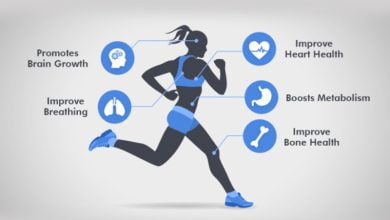
Introduction:
Mountain climbers are a dynamic and effective exercise that targets multiple muscle groups while also providing cardiovascular benefits. This full-body exercise engages the core, upper body, and lower body, making it a versatile addition to any fitness routine. Mountain climbers offer numerous health and fitness benefits, ranging from improved cardiovascular endurance to enhanced strength and flexibility. Let’s delve into the various aspects of mountain climbers and their impact on health and fitness:
Cardiovascular Endurance:
Mountain climbers are a form of aerobic exercise that elevates the heart rate and increases oxygen consumption. Performing mountain climbers at a moderate to high intensity challenges the cardiovascular system, improving its efficiency over time. Consistent engagement in mountain climbers can enhance cardiovascular endurance, allowing individuals to sustain physical activity for longer durations without fatigue. This improved endurance benefits overall heart health and reduces the risk of cardiovascular diseases such as heart attacks and strokes.Cardiovascular endurance is a cornerstone of overall fitness, and mountain climbers are an exceptional exercise for improving this vital aspect of physical health. Mountain climbers require continuous, rhythmic movement that engages multiple muscle groups while elevating the heart rate, making them an effective aerobic workout. Let’s explore in detail how mountain climbers contribute to cardiovascular endurance:
Elevates Heart Rate:
Mountain climbers are a high-intensity exercise that rapidly elevates the heart rate. As individuals perform the alternating leg movements and support their body weight on their hands, their cardiovascular system responds by pumping oxygen-rich blood to the working muscles more efficiently. This sustained increase in heart rate challenges the heart muscle and improves its ability to deliver oxygenated blood throughout the body, enhancing cardiovascular endurance over time.
Aerobic Exercise:
Mountain climbers are classified as aerobic exercise, also known as cardio exercise, because they involve continuous, rhythmic movements that increase oxygen consumption by the body. Aerobic exercise is essential for improving cardiovascular health and endurance by strengthening the heart and lungs. By engaging in mountain climbers regularly, individuals can enhance their aerobic capacity, allowing them to sustain physical activity for longer durations without experiencing fatigue or shortness of breath.
Improves Oxygen Utilization:
During mountain climbers, the body requires a constant supply of oxygen to fuel the working muscles and sustain energy production. As individuals perform this high-intensity exercise, their respiratory rate increases to meet the increased demand for oxygen. Over time, the body becomes more efficient at utilizing oxygen, resulting in improved oxygen uptake and delivery to the muscles. This enhanced oxygen utilization enhances endurance and performance during physical activity, contributing to overall cardiovascular health.
Enhances Circulation:
The dynamic, rhythmic movements of mountain climbers stimulate blood circulation throughout the body. As individuals perform the exercise, blood flow to the muscles increases, delivering oxygen and nutrients while removing metabolic waste products such as carbon dioxide and lactic acid. This improved circulation optimizes nutrient delivery and waste removal, reducing the risk of muscle fatigue and improving endurance during prolonged exercise sessions.
Strengthens Heart Muscle:
Mountain climbers provide an effective workout for the heart muscle, known as the cardiac muscle. As individuals engage in this aerobic exercise, the heart must work harder to pump blood to the working muscles, lungs, and other organs. Over time, this consistent cardiovascular training strengthens the heart muscle, making it more efficient at pumping blood and improving overall cardiac function. A stronger heart can pump more blood with each beat, resulting in a lower resting heart rate and improved cardiovascular endurance.
Supports High-Intensity Interval Training (HIIT):
Mountain climbers are well-suited for incorporation into high-intensity interval training (HIIT) routines, which involve alternating between short bursts of intense exercise and brief recovery periods. HIIT has been shown to be highly effective for improving cardiovascular endurance, burning calories, and enhancing overall fitness. By incorporating mountain climbers into a HIIT workout, individuals can maximize cardiovascular benefits, increase calorie burn, and improve aerobic capacity in a shorter amount of time compared to steady-state cardio exercises.
Conclusion:
In conclusion, mountain climbers are a highly effective exercise for improving cardiovascular endurance and overall fitness. By elevating the heart rate, increasing oxygen consumption, and stimulating blood circulation, mountain climbers strengthen the heart, lungs, and muscles, enhancing aerobic capacity and endurance over time. Whether performed as a standalone exercise or as part of a larger workout routine, mountain climbers provide a convenient and efficient way to achieve cardiovascular health and fitness goals. Incorporating mountain climbers into your fitness routine can help you build endurance, boost energy levels, and improve overall health and well-being.
Calorie Burning:
Mountain climbers are a high-intensity, calorie-burning exercise that can aid in weight loss and weight management. The vigorous, full-body movements involved in mountain climbers engage multiple muscle groups simultaneously, increasing energy expenditure and calorie consumption. The more intense the mountain climbers, the more calories individuals will burn per minute. Incorporating mountain climbers into a workout routine can help create a calorie deficit, contributing to fat loss and improved body composition. Calorie burning is a critical component of weight management and overall fitness, and mountain climbers are an excellent exercise for torching calories and shedding excess body fat. Mountain climbers are a high-intensity, full-body workout that engages multiple muscle groups while elevating the heart rate, making them highly effective for calorie burning. Let’s explore in detail how mountain climbers contribute to calorie burning:
High-Intensity Exercise:
Mountain climbers are a high-intensity exercise that requires individuals to support their body weight on their hands and toes while performing rapid, alternating leg movements. This dynamic movement pattern engages multiple muscle groups simultaneously, including the core, upper body, and lower body. The intensity of mountain climbers results in a significant calorie burn, making them an efficient way to expend energy and create a calorie deficit for weight loss.
Full-Body Engagement:
One of the key reasons why mountain climbers are so effective for calorie burning is their ability to engage multiple muscle groups throughout the body. As individuals perform the exercise, they activate the muscles of the core, including the abdominals, obliques, and lower back, to stabilize the body and maintain proper form. Additionally, the upper body muscles, such as the shoulders, chest, and arms, are engaged as individuals support their body weight and perform the alternating arm movements. The lower body muscles, including the quadriceps, hamstrings, glutes, and calves, are also activated during the jumping and kicking motions of mountain climbers. This comprehensive muscle engagement results in a higher calorie burn compared to isolated exercises that target only one muscle group at a time.
Cardiovascular Workout:
Mountain climbers are classified as aerobic exercise, also known as cardio exercise, because they elevate the heart rate and increase oxygen consumption by the body. As individuals perform mountain climbers at a moderate to high intensity, their cardiovascular system responds by pumping oxygen-rich blood to the working muscles more efficiently. This sustained increase in heart rate challenges the heart and lungs, resulting in improved cardiovascular endurance over time. The combination of high-intensity exercise and cardiovascular conditioning makes mountain climbers highly effective for burning calories and promoting weight loss.
Interval Training Potential:
Mountain climbers can be incorporated into interval training routines, such as high-intensity interval training (HIIT), which involve alternating between short bursts of intense exercise and brief recovery periods. HIIT has been shown to be highly effective for calorie burning and fat loss, as it maximizes energy expenditure and metabolic rate during and after exercise. By alternating between periods of intense mountain climbers and brief rest intervals, individuals can maximize calorie burn, increase post-exercise oxygen consumption (EPOC), and stimulate fat oxidation for weight loss.
Metabolic Boost:
Performing mountain climbers stimulates the metabolism, leading to increased calorie burn both during and after the exercise session. The elevated heart rate and increased oxygen consumption associated with mountain climbers create a metabolic demand that persists even after the workout is complete. This phenomenon, known as excess post-exercise oxygen consumption (EPOC) or the “afterburn” effect, results in continued calorie burn and fat oxidation as the body works to restore oxygen levels and replenish energy stores. By incorporating mountain climbers into a workout routine, individuals can boost their metabolism and increase calorie burn throughout the day, even during periods of rest.
Accessibility and Convenience:
One of the advantages of mountain climbers is their accessibility and convenience. They require minimal space and equipment, making them suitable for individuals of all fitness levels and abilities. Whether performed at home, in the gym, or outdoors, mountain climbers can be easily incorporated into a daily exercise routine to maximize calorie burn and promote weight loss.
Conclusion:
In conclusion, mountain climbers are a highly effective exercise for burning calories and promoting weight loss. By engaging multiple muscle groups, elevating the heart rate, and stimulating the metabolism, mountain climbers create a significant calorie burn that contributes to fat loss and improved body composition. Whether performed as a standalone exercise or as part of a larger workout routine, mountain climbers offer a convenient and efficient way to achieve fitness goals and maintain a healthy weight. Incorporating mountain climbers into your fitness routine can help you torch calories, boost metabolism, and achieve your weight loss objectives.
Full-Body Workout:
One of the key benefits of mountain climbers is their ability to provide a comprehensive, full-body workout. This exercise engages the muscles of the core, including the abdominals, obliques, and lower back, to stabilize the body and maintain proper form. Additionally, mountain climbers target the muscles of the upper body, including the shoulders, chest, and arms, as individuals support their body weight and perform the alternating arm movements. The lower body muscles, such as the quadriceps, hamstrings, glutes, and calves, are also activated during the jumping and kicking motions of mountain climbers. This comprehensive muscle engagement helps to build strength, endurance, and muscular definition throughout the entire body.Mountain climbers are a versatile and effective exercise that provides a comprehensive full-body workout. This dynamic movement engages multiple muscle groups simultaneously, making it an efficient way to strengthen and tone the entire body. From the core and upper body to the lower body and cardiovascular system, mountain climbers offer numerous benefits for overall fitness. Let’s explore in detail how mountain climbers provide a full-body workout:
Core Engagement:
One of the primary benefits of mountain climbers is their ability to target the core muscles effectively. As individuals perform the alternating leg movements, they engage the muscles of the abdominals, including the rectus abdominis, transverse abdominis, and obliques. These muscles contract to stabilize the trunk and pelvis, preventing excessive movement and maintaining proper alignment. The continuous engagement of the core muscles during mountain climbers helps to strengthen and tone the abdominal muscles, leading to improved core stability and posture.
Upper Body Strength:
Mountain climbers require individuals to support their body weight on their hands while performing the exercise. This action engages the muscles of the upper body, including the shoulders, chest, arms, and upper back. As individuals perform the alternating arm movements, they activate the muscles of the shoulders and arms, including the deltoids, triceps, and biceps. Additionally, the chest muscles, such as the pectoralis major and minor, are engaged to stabilize the upper body and maintain proper form. The muscles of the upper back, including the rhomboids and trapezius, also play a role in supporting the shoulders and maintaining alignment. By incorporating mountain climbers into their workout routine, individuals can improve upper body strength, muscular endurance, and functional fitness.
Lower Body Muscles:
Mountain climbers involve dynamic movements of the legs, which engage the muscles of the lower body, including the quadriceps, hamstrings, glutes, and calves. As individuals perform the alternating leg movements, they activate these muscles to drive the legs forward and backward. The quadriceps, located on the front of the thighs, contract to extend the knees and propel the body forward. The hamstrings, located on the back of the thighs, engage to flex the knees and stabilize the lower body. The glutes, or buttock muscles, play a crucial role in hip extension and stabilization during mountain climbers. Finally, the calf muscles, including the gastrocnemius and soleus, assist in pushing off the ground and driving the legs forward. By targeting the muscles of the lower body, mountain climbers help to improve leg strength, power, and endurance.
Cardiovascular Benefits:
Mountain climbers are a high-intensity, cardiovascular exercise that elevates the heart rate and increases oxygen consumption by the body. As individuals perform the exercise at a moderate to high intensity, their cardiovascular system responds by pumping oxygen-rich blood to the working muscles more efficiently. This sustained increase in heart rate challenges the cardiovascular system, improving its capacity to deliver oxygen and nutrients to the muscles. By incorporating mountain climbers into their workout routine, individuals can improve cardiovascular endurance, stamina, and overall heart health.
Coordination and Balance:
Performing mountain climbers requires coordination, balance, and proprioception, which is the body’s ability to sense its position in space. As individuals perform the alternating leg movements while supporting their body weight on their hands, they must maintain proper form and alignment to avoid tipping or falling. This coordination and balance challenge helps to improve neuromuscular control and motor skills, enhancing overall movement efficiency and reducing the risk of falls or injuries.
Core Stability:
Mountain climbers are an effective exercise for improving core stability, which refers to the ability of the core muscles to maintain proper alignment and control movement of the spine and pelvis. As individuals perform the exercise, they engage the muscles of the abdominals, obliques, and lower back to stabilize the trunk and pelvis against the dynamic leg movements. This continuous activation of the core muscles helps to improve core strength, balance, and posture, reducing the risk of lower back pain and injury.
Flexibility and Mobility:
Performing mountain climbers requires flexibility and mobility in the hips, legs, shoulders, and wrists to execute the movements properly. As individuals perform the exercise, they move through a full range of motion at the hips and shoulders, stretching and lengthening the muscles and joints. This dynamic stretching action helps to improve flexibility, range of motion, and joint mobility, reducing muscle stiffness and promoting overall joint health.
Conclusion:
In conclusion, mountain climbers offer a comprehensive full-body workout that targets multiple muscle groups simultaneously. From the core and upper body to the lower body and cardiovascular system, mountain climbers provide numerous benefits for overall fitness and functional strength. By incorporating mountain climbers into their workout routine, individuals can improve core strength, upper and lower body muscular endurance, cardiovascular fitness, coordination, balance, and flexibility. Whether performed as a standalone exercise or as part of a larger workout program, mountain climbers offer a challenging and effective way to achieve total-body conditioning and enhance overall health and well-being.
Core Strength:
Mountain climbers are particularly effective at targeting the core muscles, which play a crucial role in stabilizing the spine and maintaining proper posture. The repetitive, alternating leg movements in mountain climbers require activation of the abdominals and obliques to keep the hips stable and prevent excessive twisting or arching of the lower back. By strengthening the core muscles, mountain climbers improve core stability, balance, and functional strength, reducing the risk of lower back pain and injury. Mountain climbers are renowned for their ability to strengthen the core muscles, making them a popular choice for individuals looking to improve core strength and stability. The core muscles, which include the abdominals, obliques, and lower back, play a crucial role in supporting the spine, maintaining proper posture, and facilitating movement in daily activities and athletic performance. Let’s explore in detail how mountain climbers effectively target and strengthen the core:
Activation of Abdominal Muscles:
Mountain climbers require individuals to support their body weight on their hands while performing rapid, alternating leg movements. This dynamic exercise engages the muscles of the abdominals, including the rectus abdominis, transverse abdominis, and obliques, to stabilize the trunk and pelvis. As individuals perform mountain climbers, the core muscles contract to maintain proper alignment and prevent excessive movement of the spine. This continuous activation of the abdominal muscles helps to strengthen and tone the core, leading to improved core stability and definition.
Engagement of Obliques:
In addition to targeting the rectus abdominis and transversus abdominis, mountain climbers also engage the oblique muscles, which are located on the sides of the torso. The obliques play a crucial role in trunk rotation, lateral flexion, and stabilization of the spine during movement. As individuals perform mountain climbers, the twisting motion of the torso engages the oblique muscles, particularly the external obliques, to control the movement and maintain balance. This activation of the oblique muscles helps to strengthen the sides of the core, enhancing overall core stability and functional strength.
Stabilization of the Lower Back:
Mountain climbers require individuals to maintain a neutral spine position throughout the exercise, which helps to stabilize the lower back and prevent excessive arching or rounding of the spine. The muscles of the lower back, including the erector spinae and multifidus, work in conjunction with the abdominals to support the spine and maintain proper posture. As individuals perform mountain climbers, the core muscles contract to stabilize the pelvis and prevent the lower back from sagging or hyperextending. This stabilization of the lower back helps to reduce the risk of lower back pain and injury, improving overall spinal health and function.
Functional Core Strength:
One of the key benefits of mountain climbers is their ability to improve functional core strength, which refers to the ability of the core muscles to stabilize the spine and pelvis during dynamic movements. In addition to strengthening the muscles of the abdominals, obliques, and lower back, mountain climbers also enhance coordination, balance, and proprioception, which are essential components of functional core strength. As individuals perform mountain climbers, they must engage multiple muscle groups simultaneously to maintain proper form and alignment, mimicking the demands of real-life activities and sports. This functional core strength carries over to other movements and exercises, improving overall athletic performance and reducing the risk of injuries.
Prevention of Imbalances:
Weaknesses or imbalances in the core muscles can lead to poor posture, decreased stability, and increased risk of injuries. By incorporating mountain climbers into their workout routine, individuals can address these weaknesses and imbalances, improving overall core strength and symmetry. The dynamic nature of mountain climbers engages the core muscles in multiple planes of motion, ensuring balanced development of the abdominals, obliques, and lower back. This balanced core strength helps to promote proper alignment, reduce the risk of injuries, and enhance overall movement efficiency.
Increased Core Endurance:
In addition to improving core strength, mountain climbers also enhance core endurance, which refers to the ability of the core muscles to sustain contractions over an extended period of time. As individuals perform mountain climbers, they must maintain a stable core position while performing rapid, repetitive movements. This continuous engagement of the core muscles challenges their endurance and stamina, improving their ability to withstand fatigue and maintain proper form during prolonged physical activity. Improved core endurance not only enhances athletic performance but also reduces the risk of injuries related to muscular fatigue and loss of form.
Conclusion:
In conclusion, mountain climbers are a highly effective exercise for improving core strength and stability. By targeting the muscles of the abdominals, obliques, and lower back, mountain climbers help to strengthen and tone the core, leading to improved posture, stability, and functional strength. Whether performed as a standalone exercise or as part of a larger workout routine, mountain climbers offer a challenging and effective way to build a strong and resilient core. Incorporating mountain climbers into your fitness routine can help you achieve better posture, reduce the risk of injuries, and enhance overall movement efficiency and athletic performance.
Functional Fitness:
Mountain climbers mimic the movement patterns of climbing, making them a functional exercise that translates to real-life activities and sports. The coordination, agility, and dynamic nature of mountain climbers enhance overall functional fitness, enabling individuals to perform daily tasks with ease and efficiency. Whether climbing stairs, carrying groceries, or participating in recreational activities, the strength, endurance, and coordination gained from mountain climbers can improve overall quality of life and functional independence.
Flexibility and Mobility:
Performing mountain climbers requires flexibility and mobility in the hips, legs, and shoulders to execute the movements properly. Regular participation in mountain climbers can improve flexibility and range of motion in these key areas, reducing muscle stiffness and promoting joint health. Enhanced flexibility and mobility contribute to better movement efficiency, reduced risk of injury, and improved overall athletic performance.
Mental Benefits:
In addition to their physical benefits, mountain climbers offer mental benefits such as improved focus, concentration, and stress reduction. The rhythmic, repetitive nature of mountain climbers can help clear the mind, increase mental clarity, and reduce anxiety and tension. Furthermore, the sense of accomplishment and satisfaction that comes from completing a challenging set of mountain climbers can boost mood and self-confidence, enhancing overall mental well-being.
Conclusion:
In conclusion, mountain climbers are a highly effective exercise for improving health and fitness on multiple levels. From cardiovascular endurance and calorie burning to full-body strength and core stability, mountain climbers offer a comprehensive workout that targets multiple muscle groups simultaneously. Whether performed as a standalone exercise or as part of a larger fitness routine, mountain climbers provide numerous physical and mental benefits that support overall health and well-being. Incorporating mountain climbers into your workout routine can help you achieve your fitness goals and lead a more active, balanced lifestyle.




